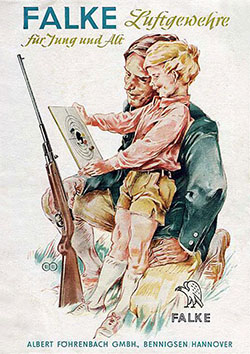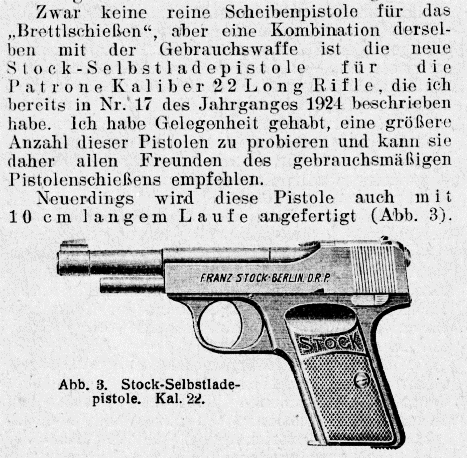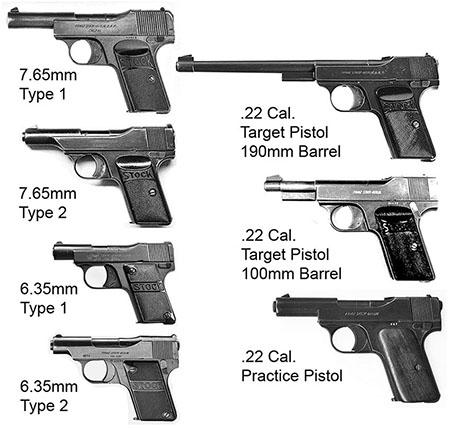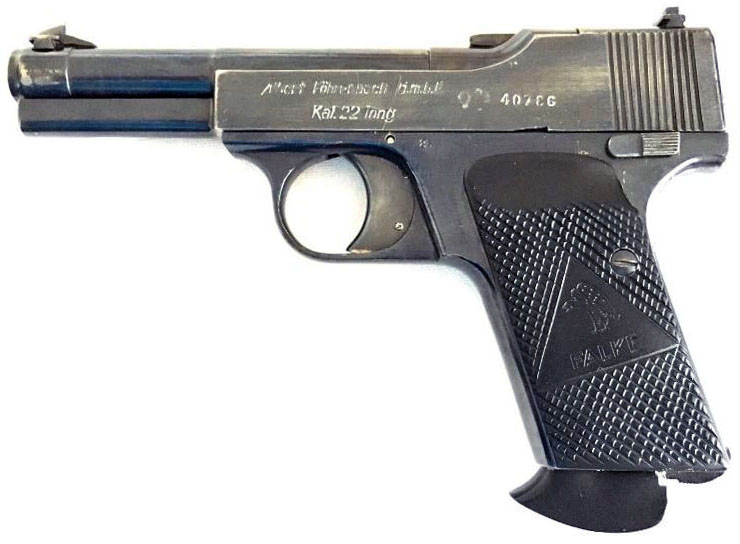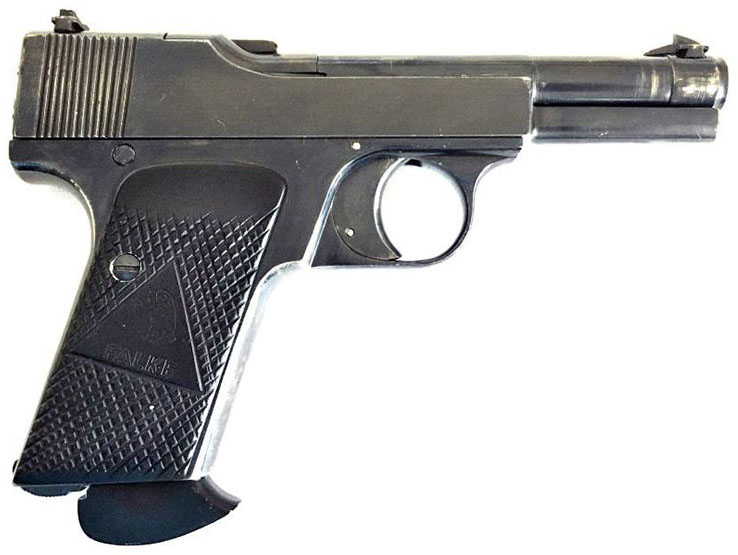 |
|||||||||||||||||||||||||||||||||||||||||||||||||||||||||||||||||||||||||||||||||||||||||||||||||||||||||||||
|
The Falke Smallbore Pistol by Dr. Stefan Klein
Föhrenbach should be well known, at least to German collectors, for high quality air rifles and pistols as well as smallbore rifles from the 1950s which were sold under the trade name “Falke” (Falcon). Albert Föhrenbach was born in 1907 in Mahlberg, Baden, and he worked during the Second World War for the Arado Flugzeugwerke GmbH (an airplane manufacturer), which had a factory in Bennigsen in the vicinity of Hannover. After the war, the area was occupied by British forces and the Arado facilities were used as a military depot. However, since Föhrenbach had a good relationship with British forces, he was able to establish a production facility for household appliances as early as 1945. Although the manufacture of weapons was strictly forbidden in postwar Germany, Föhrenbach was permitted to produce air rifles in 1947, and some years later smallbore rifles as well.
The year of production of the Falke pistol can be narrowed down to sometime between 1953 and 1959, because it shows the proofmarks (an eagle over N and a horse) of the Hannover proofhouse, which was founded in 1953. Since the Falke pistol is a virtual copy of the Stock training pistol, it is worth taking a brief excursus into Franz Stock pistols. Stock Pistols In the 1920’s Franz Stock released a series of pocket pistols in 7.65mm Browning and 6.35mm Browning which were based on the patents of Walter Decker of Zella St. Blasii (German patents 303268 and 304279). These patents were filed in 1915 and granted in 1919 and 1920. Basically, Stock pistols have a fixed barrel with the main spring around the barrel. The breech assembly is fixed in the frame with a little hook at the end of the extractor. Franz Stock changed Decker’s magazine release mechanism and filed a patent for his own design (German patent 318549) which was granted in 1920.
In 1921 Stock released his first pistol in 7.65mm Browning, and in 1923 a model in 6.35mm Browning followed. Later, in 1924, Stock introduced a .22 Long Rifle target pistol with a 190 mm barrel, which was highly successful as the first German smallbore self-loading target pistol. One year after that, Stock shortened the long barrel of his target pistol to 100mm, and advertised it as a training pistol for low priced shooting. Gerhard Bock, a well known author of the time, wrote in the magazine Kugel und Schrot in March 1925, that the new training pistol imitates in length, weight, and handling the 7.65mm Stock pistol. He also claimed that he had had very good results shooting the new Stock target pistol. As advertised, the main argument for a potential buyer would be cheaper ammunition compared to the 7.65mm Browning cartridge. However, only a few months later it was announced in Kugel and Schrot that the short barrel pistol was only available by special order. Hence the training pistol was never very successful, and so today is one of the rarest of Stock pistols.
The Falke Pistol The Falke pistol is of high quality. It is 169mm long and weighs 720g. The magazine has a matte nickel finish and holds eight rounds, which are difficult to load because the magazine has no loading aid. In contrast to the centerfire Stock pistols, the smallbore version has a separate mainspring housing beneath the barrel. The 100mm barrel has six grooves and a right-hand twist. The grip plates are made of blackened metal (possibly aluminium), which may be an homage to the Arado airplane manufacturing company.
With that, the Falcon pistol is an almost 1:1 copy of the 100mm barrel target pistol. We find some differences with the number of cartridges in the magazine (8 vs. 9), the shape of the front sight, the length of the mainspring housing, and the grip plates, which increases the weight of the pistol to about 720g compared to 650g for the 7.65mm Stock pistol. Like the .22 caliber Stock pistol, the Falke also does not have a magazine safety.
Disassembly is identical to the Stock pistol. With an empty chamber, one locks the slide in its rear position. Then one lifts the release lever on top of the breech breech block, which unlocks it. The breech block can then be pushed forward out of the slide. Finally, one removes the slide toward the front. Almost 30 years after Decker received his patents, it was up to Albert Föhrenbach to copy any features he wanted, and introduce an almost 1:1 copy of the Stock training pistol. The high serial number, however, surely does not reflect the number of pistols built. Most likely, the pistol was numbered in the same serial range with other Falke smallbore rifles. Also confusing is the caliber which reads “.22 long.” In Germany, one would normally expect “.22 lfb”. Perhaps Föhrenbach wanted to use the English nomenclature “.22 Long Rifle” but skipped the last word. Since the pistol is well made, it is probably not a prototype, and I assume that at least a small number of pistols were made. However, at this time no other pieces are known. Either the gun was unsuccessful or some difficulty was encountered with its manufacture. The Falke shared the fate of the 1925 Stock training pistol. While the target pistol with the 190mm barrel was very successful, the reduction of training costs due to cheaper ammunition did not seem to be particularly attractive for potential buyers. It would be interesting to know what customers Föhrenbach had in mind when he introduced his pistol. I assume, he was targeting hobby shooters. I would appreciate any new information about the Falke pistol. Perhaps some reader may know of another pistol or pistols somewhere. I am also interested in finding old 1953 to 1959 gun catalogs which offer Föhrenbach, alias Falke, products, and might give some hint about the Falke pistol. Thanks to Ed Buffaloe for editorial assistance. |
|||||||||||||||||||||||||||||||||||||||||||||||||||||||||||||||||||||||||||||||||||||||||||||||||||||||||||||
|
Copyright 2020 by Dr. Stefan Klein. All rights reserved. |
|||||||||||||||||||||||||||||||||||||||||||||||||||||||||||||||||||||||||||||||||||||||||||||||||||||||||||||
|
|
|||||||||||||||||||||||||||||||||||||||||||||||||||||||||||||||||||||||||||||||||||||||||||||||||||||||||||||
|
E-mail Dr. Stefan Klein |
|||||||||||||||||||||||||||||||||||||||||||||||||||||||||||||||||||||||||||||||||||||||||||||||||||||||||||||
